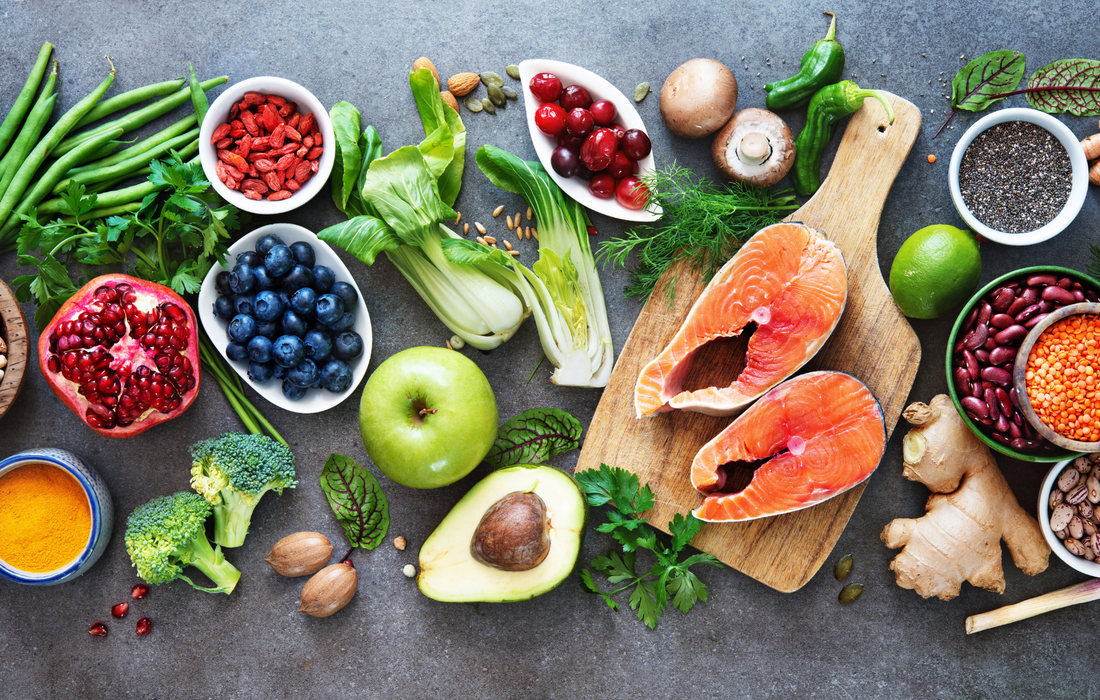Taking care of our skin health goes beyond topical treatments and skincare products. What we eat can have a significant impact on our overall well-being, especially our skin, but it can sometimes be confusing to know where and how to start. Let's dive into different areas to explore when you begin eating to maintain healthy skin!
Protein
Include a lean protein with each meal. Ensure animal protein is organic or grass-fed, and fish is wild-caught. Plant-based protein sources must be varied to include all essential amino acids.
A good portion size of animal protein is about the size of a palm. A portion of plant-based protein is around 1-2 palms. Protein helps to keep you fuller for longer and ensures more stability in blood sugar levels, which can improve overall skin health. This means blood sugar spikes and crashes are avoided, contributing to clear skin.
Healthy Fats
Include mainly monosaturated fatty acids (MUFAs) in your diet daily. Sources include extra virgin olive oil, olives, avocado, full-fat coconut milk, nuts, and seeds. A portion size is roughly the size of a thumb.
Healthy fats such as omega-3 fatty acids can support skin hydration and elasticity. Omega-3s help decrease inflammation, which is crucial since acne is often an inflammatory skin condition. Omega-3s also play a role in protecting the skin's barrier function, helping to combat issues like dry skin and excess oil, and promoting glowing skin in the process.
Skin-clearing Foods, Fruits, and Vegetables
Antioxidants can be found in many fruits and vegetables, particularly those high in vitamin C, beta carotene, and vitamin E. These substances prevent damage to skin cells caused by free radicals. They are powerful antioxidants that help protect the skin from sun damage, maintain skin health, and prevent premature aging.
Fruits and vegetables contain fiber, which assists in digestion and the elimination of toxins, so they don’t circulate through the body and cause skin issues like acne or skin issues. The high levels of micronutrients, vitamin C, and vitamin E content in produce also support liver detoxification, keeping your skin plump and reducing inflammation.
Focus on low-glycemic fruits and a variety of colorful vegetables for a balanced, healthy diet that helps with wound healing and maintaining skin health.
Fermented Foods
Your gut health plays a huge role in skin health through what is called the gut-skin axis. This is the connection between the two systems, meaning what happens inside your gut can influence the condition of your skin. Incorporating fermented foods supports both gut and skin health.
Fermented foods contain microbes that promote a healthy gut microbiome, which directly influences how your skin reacts, helping to reduce acne, allergies, and other skin issues.
These foods act as natural sources of probiotics, promoting a healthy immune system that can reduce inflammation and support clear skin from within.
Glycemic Load
The glycemic load of food is a measure of how much certain foods can raise your blood glucose levels after eating. The order in which you eat your food also matters. For example, eating protein or fiber first can slow down the absorption of high-glycemic foods, thus reducing their impact on blood sugar and insulin levels.
When blood glucose levels remain continuously high, insulin is released to bring them back to normal. Elevated insulin levels can lead to excess production of androgen hormones, which make skin cells grow quicker and increase sebum production, both of which are key triggers for acne.
Over time, consistently high blood sugar and inflammation are also considered risk factors for long-term problems like skin cancer due to the role insulin plays in cellular mutation.
To improve skin health, your goal should be to reduce the glycemic load in your diet and avoid inflammation-triggering foods.
Foods/Ingredients to Reduce:
- Processed foods: Cause inflammation and spike insulin levels.
- Refined sugar: Leads to insulin spikes, androgen increase, and more sebum production.
- Artificial sweeteners: Can cause insulin resistance, which negatively affects the skin's protective barrier.
- Dairy (unless fermented): Increases insulin due to IGF-1.
- High red meat intake: Contains BCAAs, which increase sebum production and can worsen acne.
- Spicy foods: Can generate excess heat in the body, affecting skin health.
- Excess omega-6: Can lead to inflammation and might impact the immune system, further exacerbating sun damage and skin elasticity concerns.
By following a balanced healthy lifestyle with a balanced diet, you're not only aiming for healthy skin, but also avoiding common issues associated with excess sebum, inflammation, and other skin conditions like acne. If you are concerned about specific skin issues or are considering an elimination diet to detect sensitivities, always consult with a healthcare professional for expert advice.
Thank you for reading!
This article of the Skinsider Scoop was graciously written by Naturopathic and Acne Nutritionist, Melissa Birch, and edited by the Clean Skin Club team. If you're interested in more from Melissa, please shoot us an email, follow her Instagram - @melissabirchnutrition, and check out her website here.



